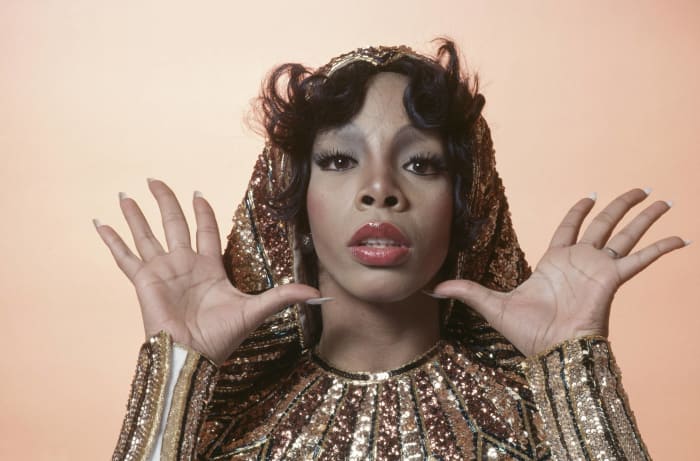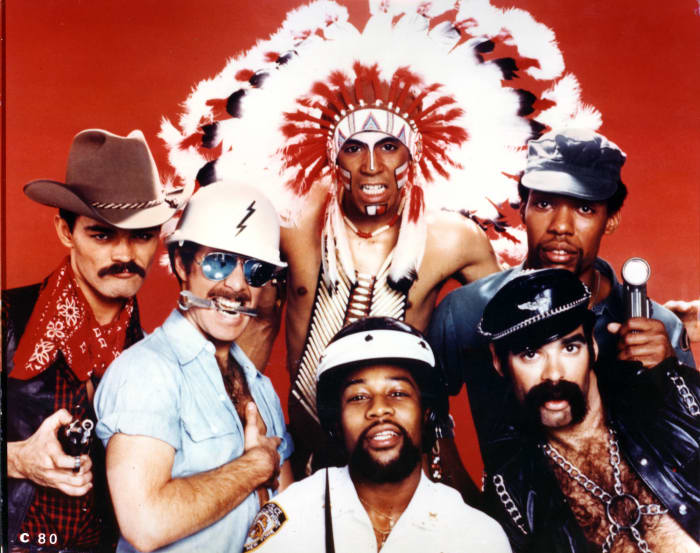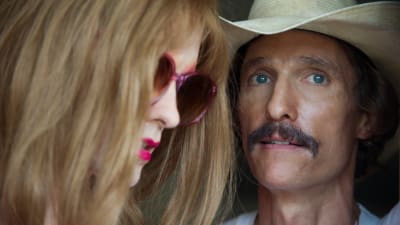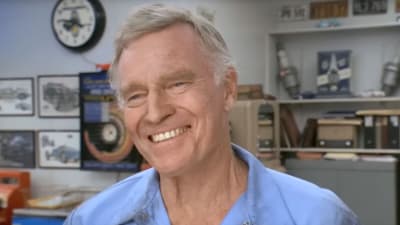It's arguably the most reviled pop cultural movement of the last fifty years, but for those who lived through its glory days, disco was a damn good time. Musically, it was an offshoot of the funk genre pioneered by James Brown and popularized by George Clinton. Culturally, it was a desperately upbeat retreat from the malaise of Vietnam and the rampant corruption of the Nixon administration. People were tired of being depressed. They wanted to feel good about something again, and if they couldn't find hope in their leaders, they could at least find a euphoric escape in a dance craze. Of course, disco was more than that. Artists like Sylvester and The Village People brought unfettered gay pride to the mainstream for the first time in the nation's history. Beneath the garish surface, disco was a good thing. Let's take a look back at the movements highlights (and maybe a lowlight or two).
Fin Costello/Redferns/Getty Images
The First Lady of Disco claimed the throne in 1975 with the release of her orgasmic dance hit, “Love to Love You, Baby” (co-written with Giorgio Moroder and Pete Bellotte). It was the first of many chart-topping hits Summer would record for Neil Bogart’s Casablanca Records throughout the 1970s. Between 1976 and 1977, Summer shot a mind-blowing ten songs to the top of Billboard’s U.S. Dance chart. Summer went on to star in Bogart’s 1978 disco movie “Thank God It’s Friday” which climaxes with her performance of the Oscar-winning “Last Dance.” Summer’s popularity faded after the death of disco, but from 1975 to 1980, disco was king and Summer was its queen.
2 of 25
K.C. and the Sunshine Band
Michael Ochs Archives/Getty Images
If disco had an official house band, it was definitely K.C. and the Sunshine Band. When the genre busted its move into the mainstream in 1975, Harry Wayne Casey and his eight-piece Sunshine Band kept disco DJs turntables smokin’ with number one hits like “Get Down Tonight,” “That’s the Way (I Like It)” and “I’m Your Boogie Man.” Sadly, when disco died, so did the band’s career. After a brief resurgence in 1983 with “Give It Up,” K.C. broke up the Sunshine Band in 1985 (though they reformed eight years later thanks to the disco revival of the early 1990s).
3 of 25
The Village People
Michael Ochs Archives/Getty Images
The camp creation of producer Henri Belolo and Jacques Morali, The Village People hit the disco scene right as the genre was peaking in 1977. No matter what you think of their music (if you say you haven’t done the “YMCA” at a wedding or sporting event, you’re a liar), the group was a positive cultural force in terms of bringing gay culture to the mainstream. Songs like “Macho Man” and “In the Navy” were irresistible dance club favorites, regardless of one’s sexual orientation. Some considered them the nadir of disco music at the time, but they were and always will be totally harmless.
4 of 25
"Saturday Night Fever"
Paramount/Getty Images
It all started in 1976 with journalist Nik Cohn’s New York Magazine article, “Tribal Rites of the New Saturday Night,” which purported to capture the burgeoning New York City disco scene. Though Cohn later revealed the article was a fraud, it was a vivid enough piece of reportage to inspire Paramount Pictures and producer Robert Stigwood to use it as the framework for the definitive disco movie, “Saturday Night Fever.” The film was a box office smash, transformed John Travolta from teen heartthrob into a full-blown movie star, reignited the Bee Gees' career and inspired everyone from kids to the school principal to start taking disco dancing lessons.
Richard E. Aaron/Redferns/Getty Images
For nearly three minutes, Diana Ross’s “Love Hangover” is the slow jam to end all slow jams – composed for the bedroom, not the dance floor. This is just the prelude for one of the most infectious disco grooves of the 1970s, courtesy of the Motown songwriting duo of Marilyn McLeod and Pam Sawyer. With the stamp of approval from a soul goddess like Ross, there could be no doubt that disco had officially arrived.
Michael Lipack/NY Daily News Archive via Getty Images
Hipster entrepreneurs caught the crest of the disco wave when they threw open the doors to Manhattan’s ultra-swanky Studio 54 in 1977. Situated near the northern tip of midtown on 54th Street (between Broadway and 8th Avenue), the nightclub was home to “the scene.” It was the playground of the rich and famous, a velvet-roped den of sin where all manner of intoxicants were imbibed with impunity – and disco provided the pulsating soundtrack. If you were lucky enough to crash the party on the right night, you could hit the dance floor and actually find yourself doing the hustle next to John Travolta! The club closed its doors in 1980 after Rubell and Schrager were arrested for tax evasion.
Michael Ochs Archives/Getty Images
When Chicagoan Don Cornelius took his televised dance party to Hollywood in 1971, the syndicated “Soul Train” became the West Coast distributor of soul, funk and, for the six or seven years it was socially desirable, disco. Dick Clark’s “American Bandstand” also glommed onto the disco craze, but if you were serious about working on your “hustle,” “bump,” and “boogaloo,” you studied the first-rate dancers on “Soul Train.”
8 of 25
Barry White and the Love Unlimited Orchestra
David Redfern/Redferns/Getty Images
No musician did more for the sex lives of adults all over the world than Barry White and his Love Unlimited Orchestra. White’s lush arrangements provided a smooth-as-silk backdrop to his seductive bass voice, but his music was just as effective for dancing as… you know. White’s 1973 hit “Never, Never Gonna Give Ya Up” had a bit of a disco vibe, but his easy up-tempo instrumental “Love’s Theme” was the apotheosis of the fledgling genre. This song was everywhere in the 1970s. You were just as likely to hear it in a nightclub as in a hotel elevator. Few tracks did more to spread the gospel of disco.
Michael Ochs Archives/Getty Images
It’s likely disco would’ve never happened without the popularization of the Philadelphia soul sound, and it’s impossible to talk Philadelphia soul without discussing The O’Jays. Even though they started out in Canton, Ohio, Eddie Levert and his band hit the R&B big time thanks to the Philly-based songwriting genius of Kenny Gamble and Leon Huff. The band’s first and only Billboard Hot 100 chart topper arrived in 1972 with “Love Train,” a feel-good, anti-war song you could disco to. There were songs before it that retroactively qualified as “disco,” but this could very well be the first true disco track.
Michael Ochs Archives/Getty Images
Barry, Robin and Maurice Gibb were teen pop music sensations in the early 1960s, and achieved worldwide stardom at the end of the decade with ditties like “I Started a Joke” and “Massachusetts.” Their popularity was on the wane in the early 1970s when they hooked into the nascent disco craze with the synth-bass-driven “Jive Talkin’” in 1975. Two years later, they contributed eight songs to the “Saturday Night Fever” soundtrack, which became the official soundtrack of the disco era. If you had to single out one song that captures disco in all of its four-on-the-floor glory, it would almost certainly be “Stayin’ Alive.”
James Andanson/Sygma via Getty Images
Nile Rodgers and Bernard Edwards were just a couple of talented musicians in their early-twenties when they joined forces to create the funk-disco outfit Chic. Their debut single “Dance, Dance, Dance (Yowsah, Yowsah, Yowsah)” hit number one on the Billboard dance chart, kicking off a string of nightclub smashes for the band that included “Le Freak,” “Everybody Dance,” and “Good Times” (which The Sugar Hill Gang would sample two years later for the pioneering rap hit, “Rapper's Delight”).
12 of 25
"Thank God It's Friday"
John D. Kisch/Separate Cinema Archive/Getty Images
Rival music labels Motown and Casablanca came together in 1978 to produce this disco musical about a culturally diverse assortment of people working in, or trying to get into, the hottest nightclub in Los Angeles. The film mixed up-and-coming young actors like Jeff Goldblum and Debra Winger with disco titans The Commodores and Donna Summer. The film received mostly negative reviews, but that didn’t keep Summer’s “Last Dance” from winning a well-deserved Oscar.
Michael Ochs Archives/Getty Images
For most of the 1970s, the music of R&B diva Gloria Gaynor was played primarily in nightclubs. Songs like “How High the Moon,” “Substitute,” and her cover of the Jackson 5’s “Never Can Say Goodbye” were discotheque favorites, but when it comes to Ms. Gaynor, it’s all about “I Will Survive.” This disco anthem was and remains a source of empowerment for mistreated women and gay men. You could call it the greatest tell-off song ever recorded, and no one would argue the point – if only for fear of drawing Gaynor’s lyrical ire.
Max Redfern/Redferns/Getty Images
There’s a film to be made about the life and musical career of Sylvester James, Jr. A prodigiously gifted R&B singer and songwriter, the out-and-proud Sylvester dabbled in performance art and avant-garde drag shows before launching his music career in 1973 with The Hot Band. Sylvester leaned toward funk early on, but he embraced disco in 1978 with dance floor scorchers like “You Make Me Feel (Mighty Real)” and “Dance (Disco Heat).” He was one of the genre’s true artistes, and, twenty-nine years after his death, his influence is felt more profoundly today than ever.
Michael Putland/Getty Images
Disco was just catching on in 1974, but martial arts movies were all the rage thanks to Bruce Lee’s posthumous box office smash “Enter the Dragon.” The thirty-two-year-old Carl Douglas was a struggling R&B musician scrambling for a B-side to his single “I Want to Give You My Everything” when he threw together “Kung Fu Fighting.” The song hit number one on the Billboard Hot 100 in December of 1974, inspiring disco fiends the world over to flaunt their martial arts moves on the dance floor. This was Douglas’s only number one hit, but it has endured.
GAB Archive/Redferns/Getty Images
The Commodores were more of a funk-soul band, but they were hip to the disco sound early on with their 1974 instrumental “Machine Gun.” The song was one of many “futuristic” sounding tracks that went crazy with Moog synthesizers, but it gets downright nasty with that rhythm-guitar breakdown that would later be sampled by the Beastie Boys for “Hey Ladies.” The Commodores had a minor disco hit in 1978 with “Too Hot ta Trot” off of the “Thank God It’s Friday” soundtrack. “Brick House” is a great dance track too, but it is not “disco.”
Michael Ochs Archives/Getty Images
Rick Dees was just a smartass Memphis disc jockey in 1976 when he decided to goof on the disco craze with “Disco Duck.” It was the biggest novelty hit of the disco era, hitting number one on the Billboard Hot 100 and rocketing Dees to radio stardom. The song’s gimmick is a spot-on Donald Duck impersonation, which led most people at the time to assume the song was a tie-in with Disney. It wasn’t, and, amazingly, Disney never attempted to sue the song out of existence (though no one today would be angry with them if they had).
GAB Archive/Redferns/Getty Images
This amiable ensemble comedy from director Michael Schultz and screenwriter Joel Schumacher wasn’t a box office success, but its soundtrack featuring the Norman Whitfield-produced music of Rose Royce caught on with disco fans. The title track became a nightclub sensation, and has endured as a kind of doldrums-alleviating workplace anthem.
19 of 25
Neil Bogart and Casablanca Records
Michael Ochs Archives/Getty Images
Music industry impresario Neil Bogart got his start in bubblegum pop, but he became a cultural force when he launched Casablanca Records in 1973. The label put out music from rock bands and funk groups, but it became synonymous with disco behind the output of Donna Summer. Bogart cemented Casablanca’s disco cred by producing “Thank God It’s Friday” and signing Parliament and The Village People.
Waring Abbott/Getty Images
The disco phenomenon is often dismissed as tacky and artistically bankrupt, but it was culturally important as a component of the 1970s gay rights movement – especially in New York City where the police had become increasingly hostile to the homosexual community. In 1970, with harassment of gay clubs on the rise, DJ David Mancuso turned his Greenwich Village apartment into an ersatz nightclub called The Loft. It was invite-only by necessity (men could dance with other men without fear of being arrested), but the exclusivity turned it into a scene for hip partygoers. The Loft’s location moved around lower Manhattan over the years, and today exists as a series of periodic house parties.
Michael Ochs Archives/Getty Images
Though Daft Punk recently brought him back to the pop music mainstream, it still feels like Giorgio Moroder is underrated. The Grammy- and Oscar-winning composer is best known by name for his synth-heavy soundtracks for “Midnight Express,” “American Gigolo,” and “Scarface,” but his behind-the-scenes collaborations with Donna Summer in the 1970s were crucial to the development of disco as a legitimate musical genre. Together, they were a pop cultural force.
Kevin Mazur/WireImage/Getty Images
The King of Pop was a latecomer to the disco craze, but he took it to another level in 1979 with the release of his classic LP “Off the Wall.” Working with producer Quincy Jones, Jackson turned out two of the biggest disco hits of all time in “Don’t Stop ‘Til You Get Enough” and “Rock with You.” The genre was about to fall out of mainstream favor, and it sounds like Jackson could sense this. Though it’s a great record in its own right, “Off the Wall” is in many ways a warm-up for the triumph of “Thriller.”
Richard E. Aaron/Redferns/Getty Images
George Clinton has done it all in just about every musical genre there is. He got his start in doo-wop with The Parliaments, flirted with Motown soul, pioneered psychedelic R&B with Funkadelic and then skipped back-and-forth between funk and disco with his mainstream party band Parliament. And while songs like “Tear the Roof Off the Sucker (Give Up the Funk),” “Flash Light,” and “Theme from the Black Hole” weren’t exclusively disco, you could certainly bump and hustle your way through them.
Ebet Roberts/Redferns/Getty Images
The Italian musician Eumir Deodato de Almeida has been all over the musical map during his fifty-three-year career. A pioneer in the 1970s synthesizer instrumental genre, he scored an unexpected disco hit in 1973 with his groovy variation on Strauss’s “Also Sprach Zarathustra.” Deodato was inspired by Stanley Kubrick’s use of the classical composition in “2001: A Space Odyssey,” and his version later found its way into Hal Ashby’s Best Picture-nominated “Being There.” Deodato went on to produce Kool & the Gang’s “Celebration.”
Catherine McGann/Getty Images
His silly Merv Griffin-produced dancing competition debuted in 1979 at the tail end of disco’s peak, but it’s significant for being hosted by the man who taught John Travolta how to disco. Though his name is primarily a pop-cultural punch line now, Deney Terrio’s contributions to the disco phenomenon shouldn’t be ignored. As Travolta’s dance coach and choreographer for “Saturday Night Fever,” his moves are being imitated to this day.

 +
+
































